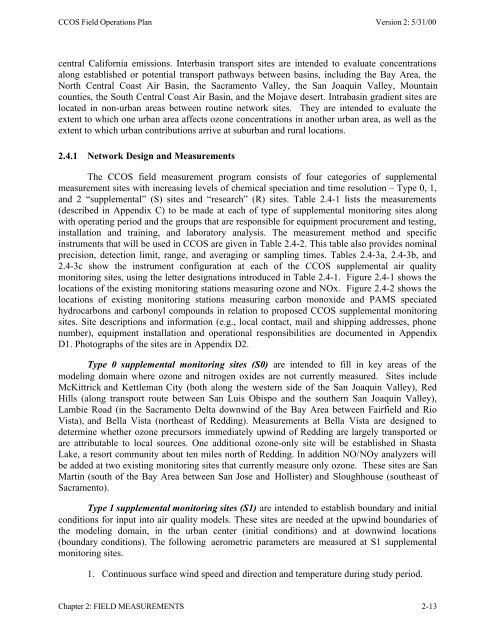Central California Ozone Study (CCOS) - Desert Research Institute
Central California Ozone Study (CCOS) - Desert Research Institute
Central California Ozone Study (CCOS) - Desert Research Institute
Create successful ePaper yourself
Turn your PDF publications into a flip-book with our unique Google optimized e-Paper software.
<strong>CCOS</strong> Field Operations Plan Version 2: 5/31/00<br />
central <strong>California</strong> emissions. Interbasin transport sites are intended to evaluate concentrations<br />
along established or potential transport pathways between basins, including the Bay Area, the<br />
North <strong>Central</strong> Coast Air Basin, the Sacramento Valley, the San Joaquin Valley, Mountain<br />
counties, the South <strong>Central</strong> Coast Air Basin, and the Mojave desert. Intrabasin gradient sites are<br />
located in non-urban areas between routine network sites. They are intended to evaluate the<br />
extent to which one urban area affects ozone concentrations in another urban area, as well as the<br />
extent to which urban contributions arrive at suburban and rural locations.<br />
2.4.1 Network Design and Measurements<br />
The <strong>CCOS</strong> field measurement program consists of four categories of supplemental<br />
measurement sites with increasing levels of chemical speciation and time resolution – Type 0, 1,<br />
and 2 “supplemental” (S) sites and “research” (R) sites. Table 2.4-1 lists the measurements<br />
(described in Appendix C) to be made at each of type of supplemental monitoring sites along<br />
with operating period and the groups that are responsible for equipment procurement and testing,<br />
installation and training, and laboratory analysis. The measurement method and specific<br />
instruments that will be used in <strong>CCOS</strong> are given in Table 2.4-2. This table also provides nominal<br />
precision, detection limit, range, and averaging or sampling times. Tables 2.4-3a, 2.4-3b, and<br />
2.4-3c show the instrument configuration at each of the <strong>CCOS</strong> supplemental air quality<br />
monitoring sites, using the letter designations introduced in Table 2.4-1. Figure 2.4-1 shows the<br />
locations of the existing monitoring stations measuring ozone and NOx. Figure 2.4-2 shows the<br />
locations of existing monitoring stations measuring carbon monoxide and PAMS speciated<br />
hydrocarbons and carbonyl compounds in relation to proposed <strong>CCOS</strong> supplemental monitoring<br />
sites. Site descriptions and information (e.g., local contact, mail and shipping addresses, phone<br />
number), equipment installation and operational responsibilities are documented in Appendix<br />
D1. Photographs of the sites are in Appendix D2.<br />
Type 0 supplemental monitoring sites (S0) are intended to fill in key areas of the<br />
modeling domain where ozone and nitrogen oxides are not currently measured. Sites include<br />
McKittrick and Kettleman City (both along the western side of the San Joaquin Valley), Red<br />
Hills (along transport route between San Luis Obispo and the southern San Joaquin Valley),<br />
Lambie Road (in the Sacramento Delta downwind of the Bay Area between Fairfield and Rio<br />
Vista), and Bella Vista (northeast of Redding). Measurements at Bella Vista are designed to<br />
determine whether ozone precursors immediately upwind of Redding are largely transported or<br />
are attributable to local sources. One additional ozone-only site will be established in Shasta<br />
Lake, a resort community about ten miles north of Redding. In addition NO/NOy analyzers will<br />
be added at two existing monitoring sites that currently measure only ozone. These sites are San<br />
Martin (south of the Bay Area between San Jose and Hollister) and Sloughhouse (southeast of<br />
Sacramento).<br />
Type 1 supplemental monitoring sites (S1) are intended to establish boundary and initial<br />
conditions for input into air quality models. These sites are needed at the upwind boundaries of<br />
the modeling domain, in the urban center (initial conditions) and at downwind locations<br />
(boundary conditions). The following aerometric parameters are measured at S1 supplemental<br />
monitoring sites.<br />
1. Continuous surface wind speed and direction and temperature during study period.<br />
Chapter 2: FIELD MEASUREMENTS 2-13
















